Music is the universal language
“Glory to God in the highest heaven, and on earth peace to those on whom his favor rests.” - Luke 2:14
General Interest
Anthology Gear Releases New Guitar Strap: Harvest
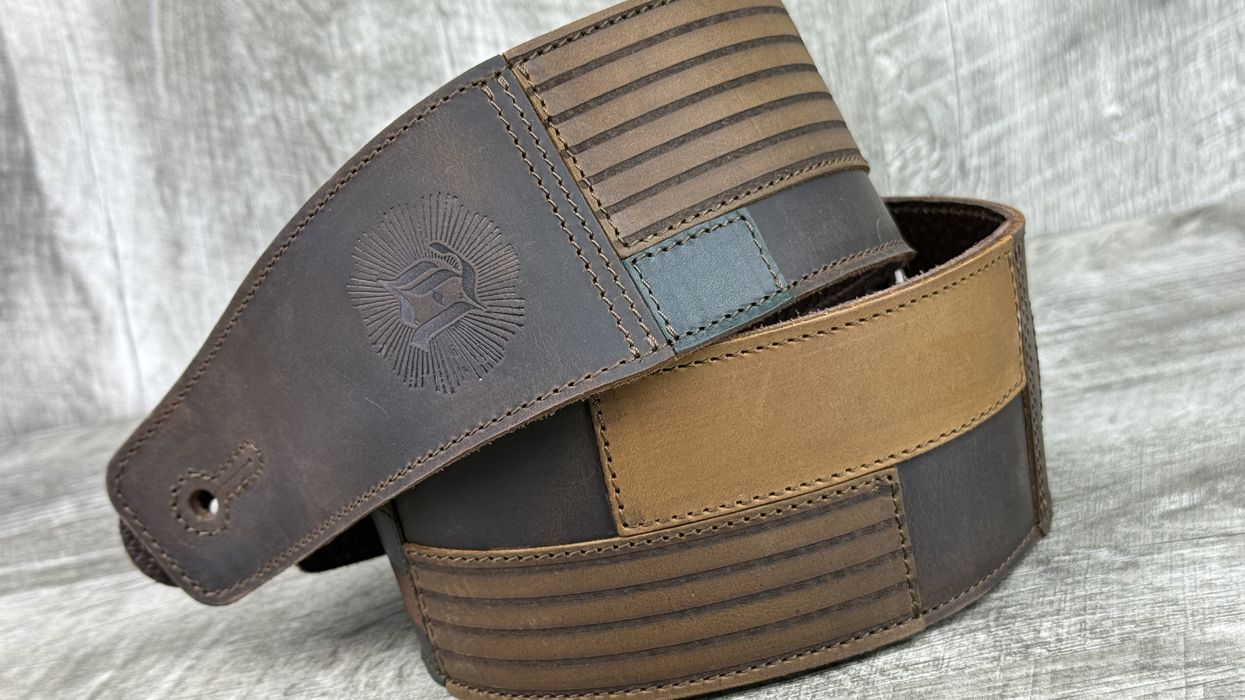
Anthology Gear has released its newest guitar strap called Harvest, inspired by the aerial view of farmlands - the patchwork of squares in varying colors of gold, brown and green that blankets the landscape. Coinciding with the 40th anniversary of Farm Aid on September 20, Harvest will support family farms via donations made to the organization.
Just prior to the release of the Harvest guitar strap, Anthology Gear made its first donation to Farm Aid and will continue to donate $10 for every Harvest strap sold on the Anthology Gear website www.anthologygear.com. Additionally, one Harvest guitar strap will be included in the Farm Aid 40 Memorabilia Auction. Often autographed by artists at the festival, these items will be open for bidding September 20 through October 3 on the Farm Aid website at farmaid.org/auction. Proceeds raised by the auction support Farm Aid’s work.
“In addition to providing high quality crafted leather goods, we want to add even more meaning to our small business and support organizations that matter to us,” says Katya Hirsch, Co-Owner of Anthology Gear.
All Anthology Gear guitar straps offer the following features:
Straps are made with high quality full grain leather which burnishes and beautifies with use
Leathers are chosen for their ability to fully distribute the weight of the guitar across the strap, for a more comfortable playing experience
A high-density premium padding maximizes comfort
Straps adjust from 39" - 54" in length; length can be extended to up to 63” with an optional jumbo tongue
Pricing for the Harvest guitar strap is $149 (with free shipping within the USA) and can be purchased directly from Anthology Gear at www.anthologygear.com.
Gibson celebrates 50 years in Nashville with the relaunch of the Les Paul Custom 70s

It’s been 50 years since Gibson set up shop in Nashville, and the company is celebrating by reintroducing a classic model to the current Gibson line – its the return of the Les Paul Custom 70s, with era-correct specs in honour of the original model.
Originally created in 1953, the first Les Paul Custom was created with a simple brief: a black signature that “looked like a tuxedo”. Over the years, it gradually shifted, with Gibson trialling out both single and double cutaway models throughout the ‘60s before settling on the single cutaway in 1968.
For two decades, the Custom 70s has only been available via Gibson’s Custom shop. Now, it’s back on the official Gibson line-up, and it has plenty of nostalgic nods to the original models. There’s plenty of classic ‘70s specs, from the mahogany body boasts a three-piece maple top, to the volute headstock adorned with the iconic Custom Split Diamond headstock inlay.
The guitar also has a ‘70s profile on the maple neck, as well as a bound ebony fretboard with 22 medium jumbo frets and mother-of-pearl block inlays. The Custom 70 also has gold hardware, including an aluminium Nashville Tune-O-Matic bridge, an aluminium Stop Bar tailpiece, and smooth-turning Grover Rotomatic, which adds a very classy, timeless touch.
 Credit: Gibson
Credit: Gibson
More ‘70s-approved features come in the form of the diamond-shaped Posi-Lok strap locks, Witch Hat control knobs and a pair of Calibrated T-Type humbuckers that are hand-wired to Orange Drop capacitors.
The Les Paul Custom 70s come in four glossy finishes: Tobacco Burst, Ebony, Buttercream Top, and Wine Red. Each guitar also comes with its own hardshell case.
This isn’t the only way Gibson has been celebrating its 50 years in Music City, Nashville. There has been plenty of nostalgia and reflecting on the company’s growth since 1975; back in July, the company announced that it was releasing 650 limited-edition Les Paul Music City Special guitars, which were inspired by Gibson’s 1970s Marauder.
The Les Paul Custom 70s costs £3,499 and is available now.
The post Gibson celebrates 50 years in Nashville with the relaunch of the Les Paul Custom 70s appeared first on Guitar.com | All Things Guitar.
“It’s the guitar I always wished existed – and now it does”: YouTuber Samurai Guitarist launches his own guitar brand

We’ve all daydreamed about our perfect guitar, mentally building a Frankenstein-ian model out of different bodies, necks and headstocks. However, not everyone has the chance to make their dream a reality – but YouTuber Samurai Guitarist has worked for over two years to bring his perfect guitar to life.
In a new YouTube video, Steve Onotera has announced that he has founded his own guitar company, Otera Guitars. The Otera TK-1 serves as the company’s debut guitar, with the turquoise electric wearing a boxier version of a Telecaster silhouette. As Onotera puts it, the Otera TK-1 is “the guitar [he] always wished existed – and now it does”.
In his announcement videos, he explains the thought process behind the guitar. “Like so many guitar players, ever since I picked up the instrument I’ve been dreaming up my own signature model,” he reflects. “However, 10 years in… no brands have expressed any interest in doing a signature guitar with me. So I figured, you know what, forget them. I’ll do it myself.”
 Credit: Otera Guitars
Credit: Otera Guitars
Limited to 100 units, the TK-1 was manufactured in Cort’s factory, a factory that has churned out gear for Fender, Epiphone, PRS and many other quality brands over the years. And it certainly sounds like a decent guitar, based on Onotera’s preview of the axe in action on his channel.
The guitar boasts a three-piece maple neck with a vintage U profile, 9.5” radius rosewood fingerboard and 21 jumbo frets. We’ve also got an ash-topped basswood body, which is finished off with a striking turquoise sheen. There’s also a choice of two interchangeable pickguards; you can opt for a standard white pickguard, or there’s an engraved floral option that’s hand-signed by Onotera himself.
The guitar also boasts a pair of Seymour Duncan pickups, with a P90 Silencer Soapbar in the neck, as well as a BG1400 in the bridge. There’s also a four-way selector.
“I want the first Otera guitars to mean something, that’s why we’re starting small,” Onotera writes on the Otera website. “For years, I imagined a guitar that felt different – one that captured everything I love about the classics, but with its own character… The TK1 is the guitar I always wished existed. Every detail was chosen for a reason, with the hope that it inspires the same passion in you that it inspires in me.”
The debut Otera TK-1 guitar costs $1,299, and comes with a Otera/Cort branded gig bag. But, of course, its only limited to 100 guitars – so once its out of stock, it will never be produced again.
Head to Otera Guitars to find out more information.
The post “It’s the guitar I always wished existed – and now it does”: YouTuber Samurai Guitarist launches his own guitar brand appeared first on Guitar.com | All Things Guitar.
Podcast 516: Isaac Stalling
On this week’s episode of the Fretboard Journal Podcast, we introduce you to Brooklyn-based guitarist Isaac Stalling.
Isaac sits down with editor Sofia Wolfson to talk about his musical roots in Oklahoma City, moving to NYC, playing in dozens of bands at once, and his solo project.
https://www.instagram.com/i_stalling_/?hl=en
Our new, 57th issue is now mailing. Subscribe here to get it.
Our next Fretboard Summit takes place August 20-22, 2026 at the Old Town School of Folk Music in Chicago. https://fretboardsummit.org
We are brought to you by: Stringjoy Strings: https://stringjoy.com
(Use the code FRETBOARD to save 10% off your first order)
Mike & Mike’s Guitar Bar: https://mmguitarbar.com
Peghead Nation: https://www.pegheadnation.com (Get your first month free or $20 off any annual subscription with the promo code FRETBOARD at checkout).
Above photo: Nicole Barley
The post Podcast 516: Isaac Stalling first appeared on Fretboard Journal.
“Alex is not doing his brother’s musical legacy justice”: Sammy Hagar blasts Alex Van Halen for ignoring his era of Van Halen in his book
![[L-R] Michael Anthony, Sammy Hagar, Alex Van Halen and Eddie Van Halen](https://guitar.com/wp-content/uploads/2025/09/Hagar-era-Van-Halen@2000x1500.jpg)
Sammy Hagar has criticised Alex Van Halen for leaving out his era of Van Halen in his memoir Brothers, even accusing the singer of “blasphemy”.
Contention is nothing new in the Van Halen world, but the latest spat comes after Hagar posted a photo of himself and Eddie Van Halen heading to the stage before a show in 1991, with discussion mainly centering around the clothes they were wearing in the era.
But the comments section took a turn when several commenters began discussing the different Van Halen eras, with one writing: “My dad always said the [David Lee] Roth days were about the party; the Sammy days were about the music.” [via Ultimate Classic Rock]
Another wrote: “No disrespect to Alex but it’s okay to like Van Halen with Sammy, even if he doesn’t anymore,” while another wrote: “Most purists believe Van Halen ended with David Lee Roth.”
Unfortunately, the latter comment provoked a response from Hagar, who wrote: “It could have [ended], my friend, but instead we went on to sell over 50 million records for [a] No. 1 album [then] sold out every building and stadium in the world for a whole decade. That never happened again.
Hagar goes on to say that Alex Van Halen is “not doing his brother’s musical legacy justice by not acknowledging all the No. 1 albums and some great music Eddie and I wrote together – not Alex – but Eddie and I wrote together”.
He adds: “To not acknowledge [those] 10 years of music is blasphemy to his brother’s musicianship, songwriting and legacy.”
Following the departure of frontman David Lee Roth in 1985, Sammy Hagar became Van Halen’s second singer, and fronted the band for 11 years until 1996. He also fronted the band again for a brief period between 2003 and 2005.
Sammy Hagar recently expressed an interest in settling his differences with David Lee Roth. After rumours swirled that DLR had mocked Hagar for claiming Eddie Van Halen visited him in a dream, Hagar asserted that this wasn’t the case, saying: “This is the first real olive-branch moment Dave and I have had in 100 years.”
The post “Alex is not doing his brother’s musical legacy justice”: Sammy Hagar blasts Alex Van Halen for ignoring his era of Van Halen in his book appeared first on Guitar.com | All Things Guitar.
“The noise of us playing thrash metal upstairs was traumatising the children”: Biffy Clyro’s Simon Neil claims the local council tried to shut down a studio he was recording in because of its proximity to a nursery

Although Biffy Clyro have made their mark on the world of alternative rock, they’re no strangers to heavier sounds. When frontman Simon Neil kickstarted his own heavy metal side-project back in 2023, Empire State Bastard was the perfect outlet of extreme thrash carnage. In fact, the project was so chaotic that it nearly got a recording studio shut down.
In a new interview, the raucous Scotsman reveals that Empire State Bastard’s debut, Rivers Of Heresy, had some rather loud recording sessions. So loud that the council had to get involved. “We spent eight days [in Todmorden’s Lapwing Studio] and it was hilarious,” Neil tells The Guardian. “Below the studio, there’s a nursery. The day we left, the council wrote to the studio asking them to close, because the noise of us playing thrash metal upstairs was traumatising the children.”
- READ MORE: Billianne on viral success, battling imposter syndrome and her years-in-the-making debut album
The “traumatising” clash of sound was a combined effort from Neil, guitarist Mike Vennart and Slayer’s very own Dave Lombardo on drums. Just listen to pummelling war cry of Stutter or Tired, Aye? and it’s hardly a lullaby – you can hardly blame the council for being a tad concerned.
However, it seems the studio was able to avoid any long-term closure. Lapwing Studio is still open, and the team have even responded to Neil’s Guardian interview – and there’s absolutely no bad blood. “Nice little quote about the studio here from Simon!” the team write on Facebook. “Said complaint is framed here in all its glory.”
When they weren’t in the studio, Neil also made a point of education Slayer’s Lombardo on the joys of Todmorden, otherwise known as the “UFO sightings capital of Europe”, apparently. “We took Dave for a curry and a pint, and whenever anyone recognised him they were in disbelief,” Neil laughs.
Elsewhere, today marks the release of Biffy Clyro’s tenth studio album, Futique. As Neil explains, it’s a record about acceptance, growth and living in the here and now. “I realised that, by ignoring painful memories, I’d been denying part of myself,” he reflects. “I found joy in understanding that everything that happens makes you who you are. It pulled me out of a fog – so the album is about embracing whatever’s happening now.”
The post “The noise of us playing thrash metal upstairs was traumatising the children”: Biffy Clyro’s Simon Neil claims the local council tried to shut down a studio he was recording in because of its proximity to a nursery appeared first on Guitar.com | All Things Guitar.
Funny Little Boxes Caught By The Fuzz review – a two-knob dirt machine that goes beyond its Britpop brief

Britpop was a moment in cultural history. Which is another way of saying that it all felt like great fun at the time but, let’s be frank, much of the music it produced has aged like raw meat in an unplugged freezer.
- READ MORE: Earthquaker Devices Fuzz Master General review – “the full gamut of vintage-adjacent fuzz tones”
People seem to have fond memories of Supergrass, though – and the Oxford trio have now provided the inspiration for an effects pedal: the Funny Little Boxes Caught By The Fuzz.
 Image: Press
Image: Press
Funny Little Boxes Caught By The Fuzz – what is it?
It’s Britpop in a box! Released in 1994, Caught By The Fuzz was the debut single that made Supergrass famous. It’s fast and catchy… and best of all, it’s got the word ‘fuzz’ in the title. To be honest, the one thing it doesn’t have is a particularly memorable guitar sound, but maybe that doesn’t matter – we’re talking about capturing the spirit of an era here, not copying an EQ curve.
FLB’s previous pedals have all been focused on American grunge tones, and this one brings a simplification as well as a change of accent: fuzz and volume are the only controls. That suggests a classic noise box in the style of the early Fuzz Faces and Tone Benders, which is certainly a promising starting point.
It’s built in the otherwise tranquil English city of Norwich, and there is one extra feature worth mentioning: instead of a simple status LED, it has a pair of blue ones that flash in sequence like the lights on a police car. Escaped convicts might find this a tad unsettling; for everyone else, it’s a welcome bit of fun.
 Image: Press
Image: Press
Funny Little Boxes Caught By The Fuzz – what does it sound like?
It turns out this pedal has more in common with the fine upstanding officers in the front of that police car than with the stoned teenager in the back – because it’s an eminently sensible and disciplined fuzz.
With both knobs pointing northwards, the first thing to report is a tidy bass/treble balance that will let you quickly forget the absence of a tone control. The mids are even-handed too – neither raspy nor scooped – and the fuzz itself is tight but thick-grained, with a nice Marshall-esque edge to hard-punched chords. It doesn’t exactly clean up when you pull back on the guitar’s volume, but it does soften down very sweetly.
There are no surprises when the gain is cranked: it’s more of the same, keeping things clear and balanced as the distortion thickens. It won’t go anywhere near Big Muff territory in terms of sheer fuzziness, though – if you need something that can also cover the sludgy grunge side of the 90s, this probably isn’t it.
Turn the fuzz down to around 9 or 10 o’clock, on the other hand, and suddenly it’s more like a low-gain overdrive: the punky element is gone, replaced by something tonally transparent but with an injection of extra body and sustain that gives real authority to single-note melodies. This low-gain sound can get rough and scuzzy with sustained chords, but it’s an extra dimension that adds genuine value to the pedal.
 Image: Press
Image: Press
Funny Little Boxes Caught By The Fuzz – should I buy it?
Does it sound like the Supergrass song? Well, yes, it can in the right setup – so if you’re planning to be Gaz Coombes in a tribute band, this pedal might be as essential as a good pair of sideburns. But, defying the apparent limitations of the two-knob format, it also has plenty to offer for anyone else who’s in the market for a really nice general-purpose fuzz.
Funny Little Boxes Caught By The Fuzz alternatives
There aren’t as many pure two-knob fuzzes around as you might think. The Jam Pedals Fuzz Phrase Si (€229/£219) is one, although it cheats slightly by having an internal trimpot for bias, and the Pedal Pawn Fuzz (£197) is another. Want something even simpler? The Beetronics Tuna Fuzz ($99/£99) only has one knob.
The post Funny Little Boxes Caught By The Fuzz review – a two-knob dirt machine that goes beyond its Britpop brief appeared first on Guitar.com | All Things Guitar.
Sweetwater Announces Full Artist Lineup for GuitarFest

The list of artists scheduled to appear at Sweetwater’s GuitarFest has been finalized. GuitarFest is taking place Saturday, September 27, on the company’s Fort Wayne, Indiana, campus. Music legends, industry leaders, and more than 70 top brands will welcome guitar lovers to this all-day event scheduled from 9AM to 5PM.

As the nation’s leading online retailer for music makers, Sweetwater has a full day of activities planned for GuitarFest attendees. Renowned guitar brands such as Gibson, Fender, Marshall, and many others will have booths, giving guitar enthusiasts the chance to speak directly with brand experts about their favorite brands. Guitar lovers will be able to get up close to thousands of guitars on display, including an entire section of unique and one of a kind guitars only available at Sweetwater.
GuitarFest will also feature appearances by major artists and other music industry notables. Confirmed artists for this year’s GuitarFest include PhilX, Yvette Young, Ariel Posen, Rob Scallon, Courtney Cox, Reeves Gabrels, Ken Susi, Freekbass, Fluff, Danish Pete, Chris Holt, Bella Perron, Bakithi Kumalo, Al Joseph, Beau Burcell, and Phil Demmel. You can see the full list of artists appearing at Sweetwater.com/guitarfest/.
Sweetwater will showcase legendary gear from the exclusive Rock & Roll Hall of Fame collection. The gear on loan includes Nita Strauss’s personal Signature Series Ibanez from her Wrestlemania tour, Slash’s Appetite for Destruction prototype that was used live from 2011 to 2025, Zakk Wylde’s iconic Gibson Les Paul, and Joe Satriani’s 1997 Ibanez JS Series Chromeboy.
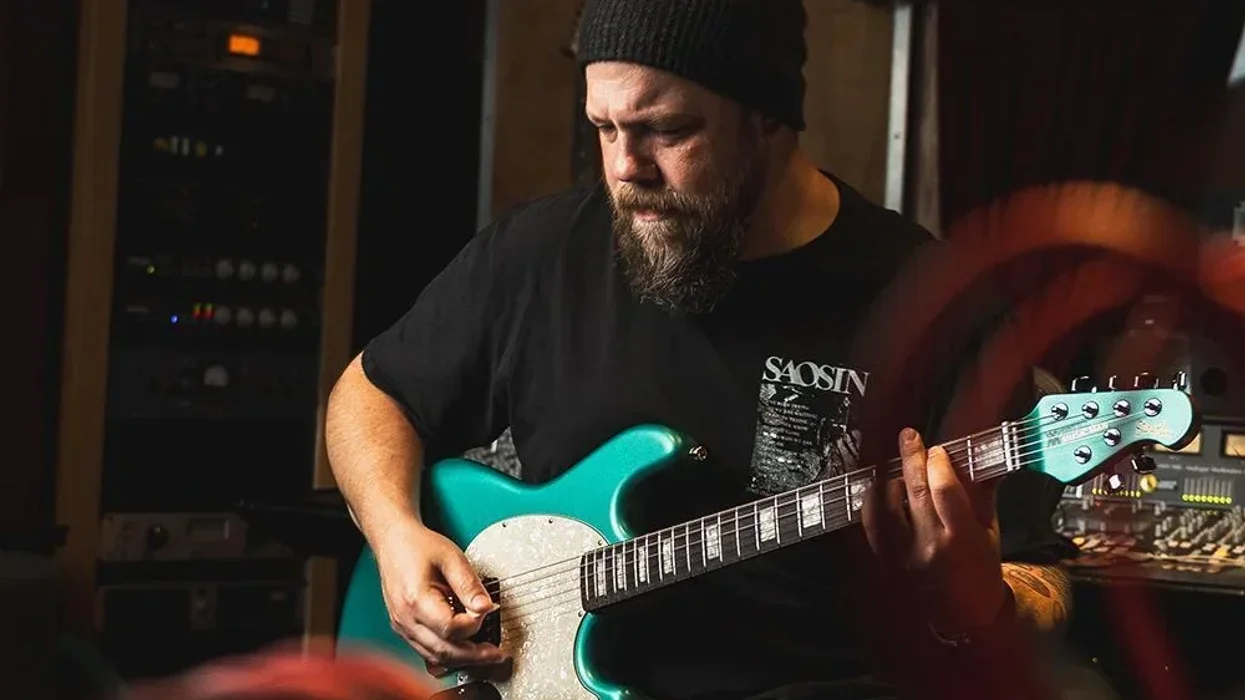
“We will have something for everyone,” said Samantha Hunter, Director of Artist Relations and Campus Events at Sweetwater. “We are creating an unforgettable celebration for music lovers. You can check out the booths from all our partner vendors, meet some amazing artists, see some amazing gear, as well as save some money with the fantastic deals we have planned.”
This year’s GuitarFest will feature the return of DealZone, a popular destination from previous events. Attendees can enjoy exclusive, in-person savings of up to 70%.
Registration for this free event is available now at Sweetwater.com/guitarfest/, where visitors can stay up to date on all the planned activities. Registrants will also be entered for a chance to win a $2,500 Sweetwater giveaway.
This event is family friendly and takes place on Sweetwater’s state-of-the-art campus located at 5501 US Highway 30 West in Fort Wayne. The Sweetwater campus includes the largest music store in the United States and other attractions for visitors to enjoy.
Benson Deep Sea Diver Fuzz-Echo Review
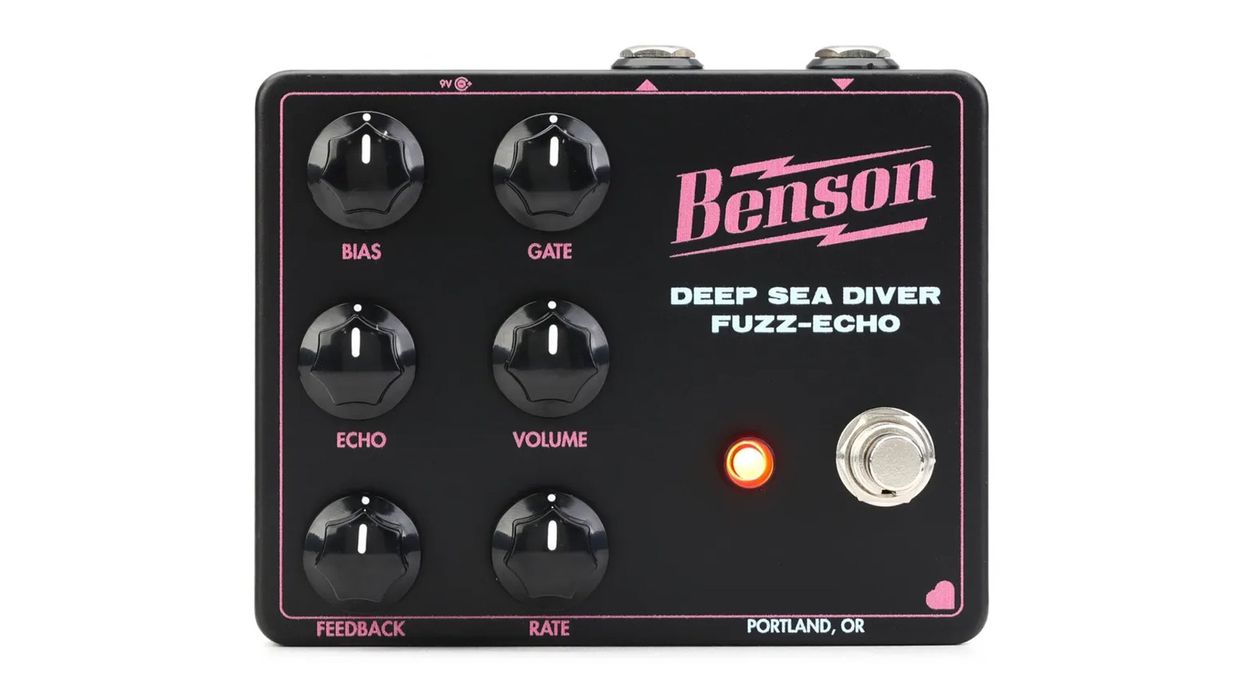
There are more flexible means for mashing up fuzz and delay than Benson’s Deep Sea Diver. And in a time of preposterously low-priced pedals, there are more economical methods, too. But there’s no guarantee that a more traditional and cost-conscious path will yield results as interesting—or inspirational—as those offered by the Deep Sea Diver. It’s a pedal that often serves up zigs where you seek zags—depending on your sense of adventure and creative latitude, it can feel versatile, forgiving, and full of exciting surprises.
Bathyspheric Battiness
The Deep Sea Diver was developed with Jessica Dobson, who fronts the band that shares the pedal’s name—and for whom more unusual applications of the fuzz/delay equation are a sonic cornerstone. The basic architecture of the Deep Sea Diver makes a great departure point for any player keen to ply the odder corners of that stompbox formula. It’s hard to know firsthand exactly what that architecture is—Benson flipped the circuit board so that you don’t see components, but rather a stylized representation of Dobson’s face in silhouette. (For the record, the solders you can see all look exceptionally tidy).
Chris Benson says that the 3-transitor fuzz section of the circuit uses a mutant mix of the 2-transitor Tone Bender MK 1.5 and the 3-transistor Tone Bender MK 2.0 as a foundation. Dobson says she envisioned a less hectic version of the ZVEX Fuzz Factory—a relation borne out here by the gate and bias controls. The delay section, meanwhile, is built around a PT2399 chip. This is a device many builders have put to creative use in spite of first turning up in karaoke machine delays. Its sonic signature—lo-fi, hazy—can be similar to that of bucket brigade delays, but still occupies a different lane than the analog EHX Memory Man and Diamond Memory Lane devices that underpin Dobson’s rig. As a whole then, the Deep Sea Diver doesn’t really replicate any particular part of Dobson’s tone recipe as much as it adds a new color formed in the spirit of where her playing has been and where it might be going.
One Deep Sea Diver feature that is a fixture of Dobson’s tone is a delay that is situated before the fuzz—except for when it isn’t. By holding down the bypass switch while powering up, you can reverse the order of the effects. If you’ve never experimented with switching fuzz and delay, the results can be revelatory.
Submarine Flip Flops
Given how interesting it is to move between the order of effects on the Deep Sea Diver, it’s a shame that you can’t make the switch without powering off the unit. Obviously, that’s not the most complicated process, but it’s also not one you’ll attempt in the middle of a song or set. Many pedals enable effect-order switching via a toggle or alternate footswitch input. In this case, the latter possibility was difficult for good reason, as pressing and holding the footswitch activates an endlessly entertaining runaway oscillation effect.
To a passively listening bystander, a switch in fuzz/delay effects order isn’t always glaringly obvious. In a very general sense, fuzz before delay results in greater clarity, and vice versa. But on the Deep Sea Diver, situating the delay before the fuzz lends a gauzy, foggy smear around the edge of transient notes and the repeats that you feel as much as hear. Comparing the Deep Sea Diver to a bucket brigade delay and a ZVEX Fuzz Factory, you can hear why Chris Benson employed the PT2399 chip. There’s a slightly more lo-fi blur to the Deep Sea Diver’s delay signature, which, to my ears, lends extra mystery.One Deep Sea Diver feature that is a fixture of Dobson’s tone is a delay that is situated before the fuzz—except for when it isn’t.
But it’s the fuzz section of the Deep Sea Diver that really expands its performance envelope. The gate and bias controls both have impressive range and work together pretty seamlessly to broaden the pedal’s fuzz voice. There are lots of collapsing, fractured fuzz-on-the fritz and dying-AM-radio sounds made more appealing by the smoky delay signal. You’ll find many shades of super-cool mid-1960s buzz, too. But it’s also capable of unique, punchy drive sounds that hit hard and are easy to compose with, and situate in a mix without sounding entirely unhinged. The Deep Sea Diver will happily go bonkers if that’s what you’re after though, and as you get a feel for the way the gate and bias controls interact you might not even miss the conspicuously absent gain level control—which, I venture, would complicate matters significantly.
The Verdict
I played the Deep Sea Diver next to a few different fuzz/delay combinations, and there is an audible cohesiveness in the two effects at the Benson's core. Furthermore, the resulting dovetailed fuzz/delay voices lend the Deep Sea Diver a truly individual voice at many settings. Though it falls short of mimicking the butter-smooth sustain of, say, a Big Muff and a Boss DD-5, it can still dish many rich fuzz tones in that spirit—just a bit filthier. The Deep Sea Diver is most certainly eccentric, just as its creators no doubt intended. But it’s not exclusively weird. There are plenty of sounds here for classicists, even if the Deep Sea Diver tends to beckon the player toward more unorthodox ends.
“I suppose I didn’t really want to be in a band”: The late Terry Reid explains why he turned down Jimmy Page’s offer to front Led Zeppelin in final interview – but reveals the other guitar icon he nearly said yes to

While the classic Led Zeppelin lineup we all know is Jimmy Page, Robert Plant, John Bonham and John Paul Jones, another musician was once in the running to front the band: the late Terry Reid.
Though fans often disagree as to why Reid ultimately passed on the opportunity – with some saying he outright turned it down and others saying it was due to his prior commitments with the Rolling Stones, Reid – who passed away in August 2025 – sets the record straight in his final interview with MOJO.
“I didn’t turn Jimmy down,” he insists. “I told him, I’ve got to go do this tour with the Stones. When I get back, let’s have a go.”
While Reid ultimately never joined Led Zeppelin, the story goes that he suggested to Page who would become the band’s singer and drummer, Robert Plant and John Bonham.
“In Birmingham I’d played with The Band Of Joy a couple of times – bunch of fucking hooligans,” Reid continues.
“When Peter [Grant, Led Zeppelin manager] and Jimmy were talking about getting people for the band, I said, ‘Whatever you do, you’ve got to try these guys out.’ I contributed half the band. That’s enough on my part!”
That he was in the running to join Led Zeppelin wasn’t the first time Terry Reid found himself with the opportunity to join bands, including Deep Purple and the Spencer Davis Group.
“I suppose I didn’t really want to be part of a band,” he says. “The only time I really considered it was with Jeff Beck. He had a sensitivity that was totally different [from] any other guitar player. But he was always going down his own path, too, so it never happened.”
“I’ve lived my life the way I wanted,” Reid concludes. “Running around, chasing your tail, chasing after this, chasing after that, it’ll do one of two things: it’ll either drive you crazy, or it’ll get you in a whole load of trouble.”
The post “I suppose I didn’t really want to be in a band”: The late Terry Reid explains why he turned down Jimmy Page’s offer to front Led Zeppelin in final interview – but reveals the other guitar icon he nearly said yes to appeared first on Guitar.com | All Things Guitar.
James Bay on Failed Solos, Onstage Adrenaline, and How to Hire a Band

On this episode, James Bay joins Cory Wong from backstage at the 9:30 Club in Washington, D.C. (It takes Wong all of 10 seconds to recognize and name the green room.) Bay is still supporting his fourth full-length record, Changes All the Time, and Wong picked up on a different guitar approach on the new album. Bay walks him through how his playing matched the collection’s title.
Bay also reveals the first solo he learned to play (or, rather, failed to learn to play; it’s a Bon Jovi hit), and how Jack White’s philosophy of struggle against his instrument has shaped Bay’s relationship to his own guitars. As bandleaders, Wong and Bay both have plenty of experience hiring players to join them in studio and on the road, so what do they look for when selecting colleagues? Tune in to find out.
It wouldn’t be a chat with a Minnesotan guitarist without some Prince talk, so stick around to learn the appropriate etiquette for covering The Artist when touring his home state.
New “Broken-In” P-Bass Feels 60 Years Old
Realistic vintage-like wear on the neck and body of this rock-solid P-Bass make it feel as familiar as a favorite sweater.
Featuring a variety of vintage colors finished in Road Worn® aged nitrocellulose lacquer, the Vintera II Road Worn ‘60s Precision Bass recreates the look and feel of a well-played classic. The limited Road Worn models are enhanced with a new subtle aging process combining light checking, gentle wear patterns and a semi-gloss finish, while maintaining the authentic broken-in feel players love about vintage Fenders. The ‘60s “C”-shape maple neck with 7.25” radius rosewood fingerboard and vintage-tall frets provides supreme comfort and outstanding feel. Under the hood, you’ll find a vintage-style ‘60s split-coil Precision pickup that delivers all the warm, dynamic and powerful tone that made Fender famous. The vintage-style 4-saddle bridge and vintage-style tuning machines provide classic looks with enhanced intonation and tuning stability to complete the package. Options include Rosewood Fingerboard in Fiesta Red and Charcoal Frost Metallic.
“They used a lot of the old tricks that we all kind of did”: Aerosmith recall being ‘annoyed’ by Van Halen at first

When Van Halen burst onto the hard rock scene in the late ‘70s, they didn’t just make an impression, they shook the established order. For Aerosmith guitarists Joe Perry and Brad Whitford, their first encounter with the band was a mix of annoyance and awe.
In a recent interview with Rick Beato, the pair open up about their initial reactions to the group that would go on to redefine rock guitar.
Perry, in particular, admits he was initially baffled by Eddie Van Halen’s approach: “Well, first of all, it was kind of annoying,” he says [via Ultimate Guitar]. “It’s like, we didn’t know what he was doing. I mean, we knew a little bit about it. I remember Bill Lawrence used to do the tapping, when he’d sit and write… But it was like, damn… like the equivalent of Jeff Beck; somebody who was just kind of out of reach.”
But what frustrated him at first soon turned into admiration. “I mean, the more and more I listened to his stuff, it just blew my mind, because it’s so tasty. There was nothing schlocky ever in it.”
Whitford adds that Van Halen’s relentless work ethic and tight chemistry set them apart from their peers: “And the power, like when I read Alex’s [Van Halen] book – you read that, and then get an understanding how, day in and day out, they would get up in the morning, and go play together till midday, every day,” he explains.
“And then, you listen to these records, and you hear the lock that those two guys had, and the power that they had. It was like, ‘Whoa, that’s one of the most powerful bands I’ve ever heard.’”
For Perry, it wasn’t just the playing – it was the way Van Halen completely reimagined the hard rock formula.
“On that first record… When I heard that, it was like, they used a lot of the old tricks that we all kind of did and left behind. They took it, and turned it up to 11,” says the guitarist. “And that first album was fucking stunning… I remember, when they were playing clubs, that [Eddie] would turn around and do shit so people couldn’t see what he was doing. And, God, if people could see it, I don’t think they could do it anyway.”
Watch the full interview below.
The post “They used a lot of the old tricks that we all kind of did”: Aerosmith recall being ‘annoyed’ by Van Halen at first appeared first on Guitar.com | All Things Guitar.
Cort’s Earth GO packs traditional acoustic craftsmanship and modern smart tools – including looping, effects, and Bluetooth – into a compact travel guitar

Looking for a guitar that’s as at home on the road as it is on stage? Cort Guitars’ Earth GO combines traditional acoustic craftsmanship with intelligent, performance-focused features, delivering a portable, versatile instrument without compromising the tone musicians love.
Perfect for players seeking portability, creativity, and a modern edge, the Earth GO keeps the familiar feel of an acoustic guitar while adding a suite of smart tools for practice, recording, and live performance.
The Earth GO sports a 3/4 size mini dreadnought body, making it ideal for travel, casual playing, or players with smaller hands. Its solid Sitka spruce top delivers clarity and responsiveness, while mahogany back and sides deliver warmth and depth. According to Cort, this classic tonewood pairing ensures a balanced and resonant acoustic voice.
The guitar’s mahogany neck features a comfortable “C” profile and a 22.8” (578mm) scale length, complete with a laurel fingerboard with 6mm white dot inlays and a 15.75” radius. With a PPS nut (43mm wide) and 19 frets, the guitar offers accurate intonation and a natural playing feel.
 Credit: Cort Guitars
Credit: Cort Guitars
At the core of the Earth GO is the HyVibe H2 smart system, which turns the guitar into a mini performance hub. Built-in effects – reverb, chorus, delay, tremolo, octaver, phaser, and distortion – eliminate the need for external pedals. Players can stream backing tracks via Bluetooth, loop melodies, tune up with the onboard tuner, or keep time using the integrated metronome. Whether practicing at home or performing live, these intuitive tools offer unmatched creative freedom.
In terms of hardware, we’ve got die-cast tuning machines with black knobs, a dual-acting truss rod for easy neck adjustments, and a laurel bridge with a PPS saddle. The guitar also comes factory-equipped with coated strings for durability and playability, and each instrument includes a gig bag for added portability.
Available in Open Pore and Open Pore Brown Burst finishes, the Cort Earth GO can be picked from Thomann for $431 / £382.
Learn more at Cort Guitars.
The post Cort’s Earth GO packs traditional acoustic craftsmanship and modern smart tools – including looping, effects, and Bluetooth – into a compact travel guitar appeared first on Guitar.com | All Things Guitar.
“Dear UPS, where are my guitars?”: Johnny Marr slams UPS over “lost” guitars ahead of tour

Johnny Marr versus Morrissey is one thing, but Johnny Marr versus UPS? That’s a whole different headache.
Days before kicking off a short run of East Coast shows, the Smiths guitarist claims that UPS has misplaced several of his touring guitars – including at least one Fender and one Gibson.
Marr aired his frustrations on X, saying his gear vanished more than a week ago. “Dear UPS where are my guitars? They disappeared a week ago. I’m hearing from you now that they’ve been lost. Explain,” he writes.
Though what really set him off was the courier’s request for a description of the instruments.
“Asking me to describe what my guitars look like is not filling me with confidence,” Marr quips. “They look exactly like the ones you put in one of your delivery vans days ago. Remember?”
And just in case anyone at UPS needed more detail, Marr helpfully adds: “Look for one that says ‘80’s Icon’ on the case and another one that says ‘Woke As Fuck’”
The guitarist – whose devotion to six-strings even earned its own photo book, Marr’s Guitars (2023) – didn’t hold back on hashtags either, tagging Fender and Gibson along with a blunt #fuckUPSinc and #freemyguitars.
UPS is reportedly investigating the case, though as of writing there’s no sign of Marr’s missing gear. With his tour dates looming, here’s hoping those cases turn up sooner rather than later.
Check out his tweets below.
Dear @UPS where are my guitars ? They disappeared a week ago. I’m hearing from you now that they’ve been lost. Explain @fender @gibson #fuckUPSinc #freemyguitars
— Johnny Marr (@Johnny_Marr) September 17, 2025
Ring Ring @UPS #freemyguitars #fuckUPSinc
— Johnny Marr (@Johnny_Marr) September 17, 2025
Knock Knock @UPS #freemyguitars #fuckUPSinc
— Johnny Marr (@Johnny_Marr) September 17, 2025
Bang Bang Bang @UPS. Asking me to describe what my guitars look like is not filling me with confidence. They look exactly like the ones you put in one of your a delivery vans days ago. Remember ? #fuckUPSinc #freemyguitars
— Johnny Marr (@Johnny_Marr) September 17, 2025
Look for one that says ‘80’s Icon’ on the case and another one that says ‘Woke As Fuck’ @UPS
— Johnny Marr (@Johnny_Marr) September 17, 2025
The post “Dear UPS, where are my guitars?”: Johnny Marr slams UPS over “lost” guitars ahead of tour appeared first on Guitar.com | All Things Guitar.
“Playing guitar is inherently a very cool thing to do” Wisp on leading the shoegaze revival with a sprinkling of nu metal thrown in

San Francisco phenom Wisp (Natalie Lu) has mastered an unexpected musical hybrid: shoegaze meets nu-metal. Think rage, fury and catharsis meeting dreamy, luscious layers of fuzz, echo and woozy synths. If that tagline doesn’t land her on your must-listen, then perhaps Deftones’ advocacy will. The band chose Wisp to open their tour, and they’re not the only ones. Korn, System of a Down, and Avenged Sevenfold have all booked her for support. Lu will hit the touring route with all new material.
- READ MORE: Billianne on viral success, battling imposter syndrome and her years-in-the-making debut album
Back in August, Lu released her debut album If Not Winter. Only two years’ earlier, the viral popularity of her single Your Face attracted Interscope Records (the Universal-owned label has an eclectic mix of artists, also boasting BLACKPINK, 2hollis, Jennie Kim, Rema and Kendrick Lamar). Your Face was a hypnotic beast, showcasing Wisp’s breathy, ethereal vocals with the expertise of post-punk producer grayskies (aka Vinicius Masashi Honda Takada). Far from a love song, Your Face is the ultimate “it’s not you, it’s me” track, as Lu laments that she just can’t reciprocate the sort of desire and commitment promised by a lover. But, it’s more than that. The song, in its immense torrent of sound and emotion, captures that sense of emptiness and impotence that is almost universal in our geopolitical fuckstorm of disaster. As much as we want to feel compelled, vulnerable, in love with this world, there’s a void between what we want to feel and what we actually do.
Lu has built her own world, perhaps as a safer space to live out her feelings. Perhaps, as might befit a former computer science student, it’s a fantasy of swords, serpents, swans and mythical objects. It’s evidently chiming with a ready intergenerational audience too, with Coachella and Bonnaroo adding her to their lineups.
 Image: Elinor Kry
Image: Elinor Kry
Moving Out And Moving On
When Lu appears on video call from her home in Los Angeles, she’s in the midst of packing, which she assures Guitar.com is fun. She’s lived in the City of Angels since January 2024, the first time she’s lived alone.
Now that If Not Winter is out in the world, Lu says, “It’s a really surreal feeling, and I think that it’s definitely difficult to grasp all of the emotions that come with releasing a project that means so much to me. The night it came out, I was just very overwhelmed, but so filled with gratitude and love. And, I felt very accomplished because I’ve been working on this album for almost two years now, and I put so much of myself into it. So finally having it out, and for it to be not just my album, but everyone else’s, it just feels amazing.”
For an album so lush and layered, it might surprise listeners to learn that most of the sound is live instrumentation. Lu played guitar alongside her studio and live guitarist Max Epstein.
“I would say 85 percent of the album is live instruments, and the rest, 15 percent, are just synths that we put in MIDI and digitally. But all of the guitars, the drums, bass, all of that is live, real instruments,” says Lu.
Learning to shred was a natural progression from violin, she explains.
“I grew up playing violin, and I think that a lot of the music theory from violin helped transition me into playing guitar. So, I started playing guitar when I was around 15 years old. I kind of played piano too, but I’m not the best at it, so I don’t really like to say that I actually played piano. I picked up bass when I was around 16 or 17 years old. I guess bass and guitar kind of go hand-in-hand in some aspects. But on the album, I mainly just played guitar.”
 Image: Elinor Kry
Image: Elinor Kry
A Rotating Cast
As befits an artist who is so comfortable criss-crossing the genre lines, her gear was equally diverse.
“On the album, there was a mix of different guitars just because I was at different studios all of the time, but I used a Strat on some of the songs,” she reveals. “I used a Les Paul Goldtop on some songs, and during my live sets, I love using Jags and my Harmony guitar. So those will make it onto the album, sometimes as well.”
Lu can’t recall which year the Goldtop was, but it was definitely vintage and definitely, she states, worth over $10,000. Owning one is a future dream for now, but Lu can trace her passion back to being a teenager with no such lofty ambitions.
“When I first started getting into guitar, I was really into bedroom pop at the time, and I was also into old rock music a lot too. So just watching YouTube videos of people in bands playing guitar. I was just so astonished and inspired, and also playing guitar is, at least to me, inherently a very cool thing to do. So obviously, growing up, I wanted to be a rock star, but I looked up to people like Elliot Smith, and I was also very into Oasis, Black Sabbath and Jimi Hendrix. Seeing these people shred and just be so good at their craft, it really inspired me to get into playing guitar.”
Lu played a Fender Vintera II 70s Jaguar on her first headline tour, but she’s moved on to what is her new favourite.
“I recently bought a new Jag” she enthuses. “The Johnny Marr Jag is the best guitar that I own, I love it so much. It feels amazing. I love that it’s short-scale. I was looking for an all-white guitar too, so it’s perfect. It has an interesting layout because the different pickup settings are so vastly different from each other. So, when I play it, I’m able to get a brighter tone. I’m able to get a more smooth, warm tone. And I like that the kill switches aren’t a traditional kill switch, and it doesn’t actually act as a kill switch, but it enhances the brightness on some of the pickups. The knobs are really sick too. I love the color of the neck, and it looks so nice along with the fact it plays so well and just feels great. It’s a very well-made guitar.”
 Image: Elinor Kry
Image: Elinor Kry
Words And Picture
Lu’s taste in oddball guitars stretches to a non-standard attitude to lyrics too. Her songwriting process is all about an organic, unforced approach.
“I usually start with guitar, and [writing the] lyrics depends. I might think of them on the way to the studio and write them into my phone, but at other times I’ll write them after the guitar and bass are tracked and I’m feeling out the landscape of a song. As long as lyrics come to me naturally and I’m not taking more than 30 minutes to write them. The less time I have with them, the more raw and honest they sound.”
Lu points to Guide light as one of those raw moments. It’s a plea for a friend, or a lover, to reassure that they’ll still be there, even when we’re burnt out and the worst in us is on show.
“Who will guide me when I can’t do this anymore? (When I can’t do this, will you?) Tell me something is your love enough to live for?”
Lu says, “Guide light was the only song on the album that was recorded as a live band all playing together. and there are so many little fun elements added post-recording. You can really see my taste, and [producer] grayskies’. I was playing theremin, which is that really haunting sound you hear, and we also overlaid more guitar. That’s when I fell in love with the Les Paul Goldtop vintage, in that session.”
Just when Lu had locked in on her tracklist and was ready to hand in the final album, her team convinced her that one more song could round it out. Black Swan resulted.
“I thought the album was done,” Lu confesses. “My team and the people around me encouraged ‘one more song’. I said ‘absolutely not, I’m burnt out, I’m done’. Then I went into studio with [producer] Kraus, and we wrote this song I was unsure of in the beginning but after a couple of days, it was turning out really well. I sent it to Max, my guitarist, and he was like, ‘This is so good! This is the best Wisp song ever.’
The last minute addition, she says, “was exactly what the album needed. And I love working with Kraus. I think he’s one of the most talented people and producers that I know, so getting to have him on this project is very special. He produced Pandora, as well.”
Tone Deaf
Wisp is a magnet for the big names in talent – both in production and on tour. The upcoming tour with Deftones is looming.
Lu says, “Deftones have been a really big inspiration in my music. The little breath sound I do in Your Face is inspired by Be Quiet and Drive (Far Away) because Chino [Moreno] does that in a couple of his songs. So, this is such an amazing opportunity, a full circle moment, to tour with people I look up to. Obviously, it’s such a big deal to me.”
It’s also an opportunity to get past her shyness and speak to the Deftones frontman.
“I saw Chino at a festival we played a few weeks ago, but the band and I were too quiet to say hi to him even sitting at the same table.”
Lu recognises that as amazing as this opportunity is, it doesn’t come without some haters. Her role representing women singer-songwriters in shoegaze, and alt-rock in general, is one she really cares about.
“Going into music and making shoegaze, which is dominated by predominantly white men since the 90s, I’m putting myself out there and understanding that I will get some hate and backlash,” she says.
“Being a woman in this field in general is a daunting thing, but it’s necessary. When people like me, and other shoegaze and alt-rock bands, that’s important representation. Other girls have reached out to me and said it’s inspired them to get out there and make music on their own too, and I really attach myself to that. Growing up, I would have wanted to see more female-fronted rock and alt-rock bands. Sometimes people feel threatened and attribute success to how a woman looks. It’s a lot easier to be acknowledged for hard work and efforts when you’re a man in this industry.”
But Lu doesn’t back down. She’s developing a thick skin, an industry must-have.
“I’ve been getting a lot better at just blocking out all of the hate and reminding myself that people see me as out of the norm, and while some see that in a negative light, other people see it in a positive light, and are able to become inspired because there are so many other girls similar to me that that want to make music. It’s just a very special thing to be able to put myself out there and see how that affects other people.”
If Not Winter is out now on Interscope.
The post “Playing guitar is inherently a very cool thing to do” Wisp on leading the shoegaze revival with a sprinkling of nu metal thrown in appeared first on Guitar.com | All Things Guitar.
The Truth About Vintage Amps, Ep. 153
It’s the 153rd episode of the Truth About Vintage Amps and Skip is having a happy day fielding your amp questions. From cleaning tweed to Magnatone varistors and all points in between, it’s 90 minutes of tube amp knowledge, laughs, and some serious California trivia.
Some of the topics discussed this week:
1:27: The 2025 Fretboard Summit; the importance of repair tags
6:55: Thanks for the mangos, John! And a food preservation tip
8:30: Our sponsors: Grez Guitars; Emerald City Guitars and Amplified Parts!
14:15 What’s on Skip’s bench? 60 amps in August; great Loma Rica deals; far out tubes
23:29 The big TV tubes in Standel amps (6DQ6 tubes, regulator tubes)
25:49 Skip’s near-death experience; The Edwin Hawkins Singers’ “O Happy Day” (YouTube)
31:05 Colman’s Hot Mustard
31:49 A giant yard sale in Dixon
34:23 More TAVA t-shirts; whatever happened to Jason’s Honda Scrambler?
38:04 An antique radio museum in Marysville, California
41:38 Calculating output transformer primary impedance
47:37 Cleaning tweed
49:58 Replacing the varistors in Magnatone/Americana amps; luthier Ken Bebensee; North San Juan, California; the Malakoff Diggins
56:53 Going to Guitar Center, a Gibson GA-20…or was it? Sierra Nevada Brewing Oktoberfest beer
1:01:20 The Rustic Kegger community on Facebook: https://www.facebook.com/groups/tavapodcast
1:02:51 El Pato in Alaska
1:03:41 Fender Tone Ring cabinets
1:05:54 A brown 1962 Fender Super with an 8516 transformer from a TV-front Super
1:11:01 Building a shell for a Falcon chassis
1:12:55 Building a Deluxe 5E3 clone in Brazil
1:20:17 Verellen’s solid-state Octal tube (link); how power attenuators work; Benson’s Monarch Plus power scaling
1:24:41 Recommended music: Texas Alexander & Lonnie Johnson’s “Crossroads” (YouTube); KZFR; Julian Lage; Bill Frisell
1:26:19 Noel Boggs and his Day Sleepers’ “Steelin Home” (YouTube)
1:27:16 Recommended reading: The RCA RC-30 tube manual (Amplified Parts link); California’s two Sebastopols
Need amp tech Skip Simmons’ advice on your DIY guitar amp projects? Want to share your top secret family recipe? Need relationship advice? Join us by sending your voice memo or written questions to podcast@fretboardjournal.com! Include a photo, too.
Hosted by amp tech Skip Simmons and co-hosted/produced by Jason Verlinde of the Fretboard Journal.
Don’t forget, we have a Patreon page. Support the show, get behind-the-scenes updates and get to the front of the line with your questions.
Above: Listener Rafael’s 5F2A-ish build in Brazil. Below: Jay’s El Pato sighting in Alaska.

The post The Truth About Vintage Amps, Ep. 153 first appeared on Fretboard Journal.
Taylor Guitars Adds Three Models to Successful Gold Label Collection
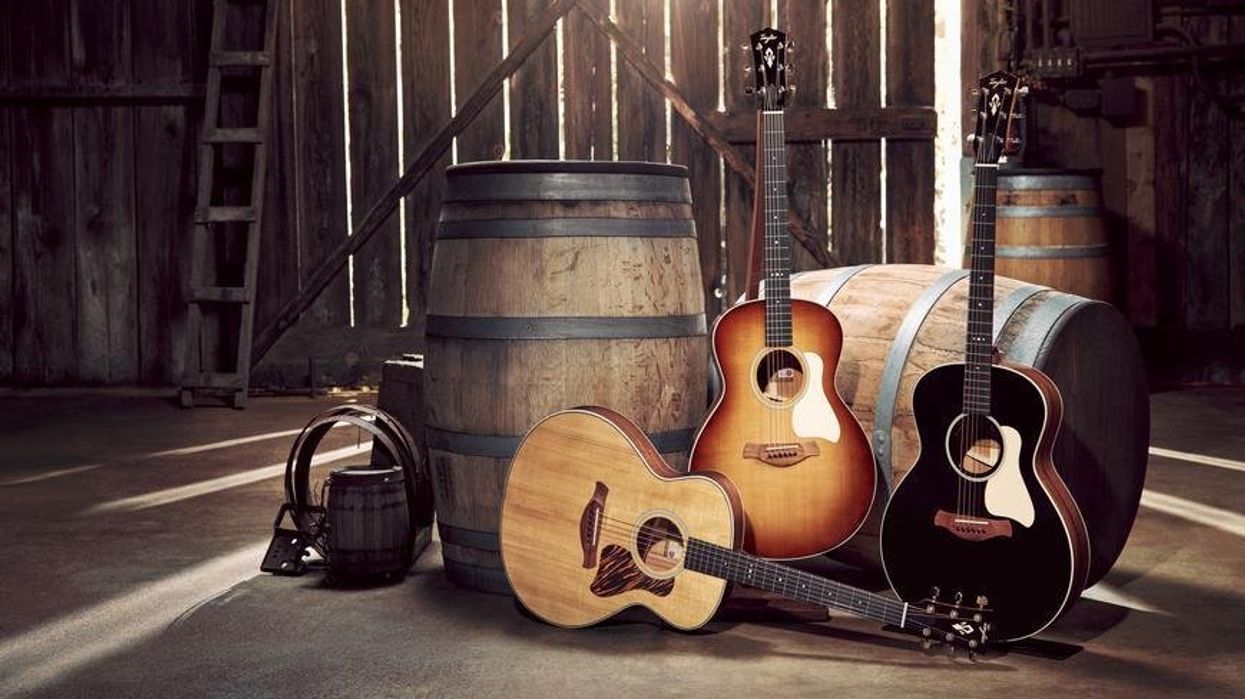
Today, Taylor Guitars, the leading global builder of premium acoustic guitars, announced the expansion of its Gold Label Collection with three new models: the Gold Label 514e, Gold Label 714e, and Gold Label 817e. The launch follows the success of the Gold Label Collection 814e introduction in January and Grand Pacific models in June, reflecting strong market demand for the heritage-inspired line. The new models bring the Gold Label collection to 18 total models, offering players more options within Taylor's premium acoustic range that delivers a rounder, warmer, more robust flavor of acoustic tone. The models are available at authorized Taylor dealers worldwide and on taylorguitars.com.
Three Defining Innovations
The Gold Label Collection showcases three key innovations that set it apart from traditional Taylor offerings. Fanned V-Class® Bracing features a fan-like arrangement of braces in the soundboard's lower bout, delivering on the original promise of a flexible voicing platform that gives these models a warmer, more resonant, more powerful sound. The patented Action Control Neck® features a long-tenon neck joint that extends deeper into the body to boost low-end resonance while maintaining a slim, fast-playing profile. It also enables quick, precise string height adjustments with a turn of a bolt through the soundhole without the need to remove the neck or strings. Completing the package, the collection's Heritage-Inspired Aesthetics draw from old banjos and mandolins, early Taylor designs, and Powers' pre-Taylor archtop work, featuring his modified headstock shape with an angled back cut and a script-style Taylor logo inlay and unique pickguard shape.
Gold Label 514e Super Auditorium
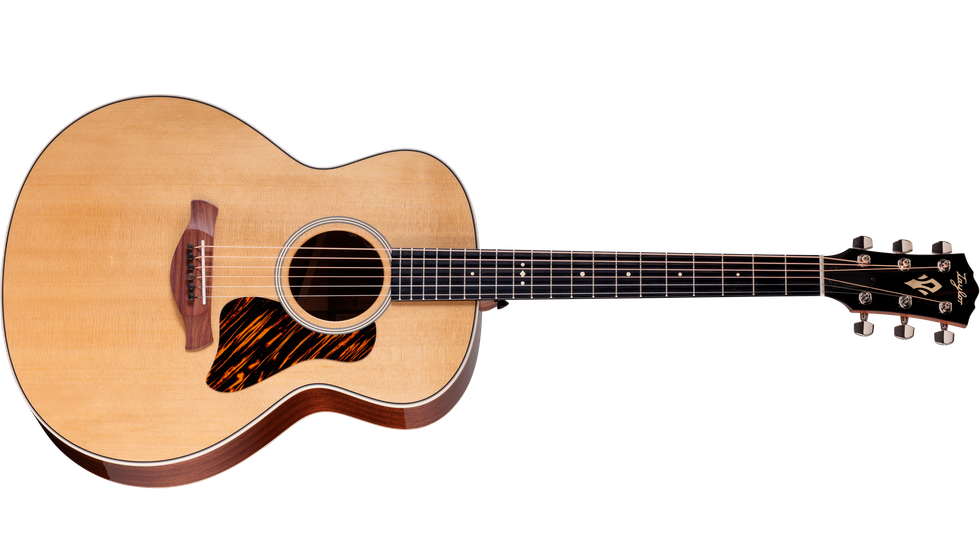
Solid mahogany back and sides paired with torrefied Sitka spruce deliver a rich, earthy midrange character with woody response and powerful projection. Available in natural, blacktop or golden-brown sunburst finishes with cream-colored "Crest" inlays and cream body binding.
Gold Label 714e Super Auditorium
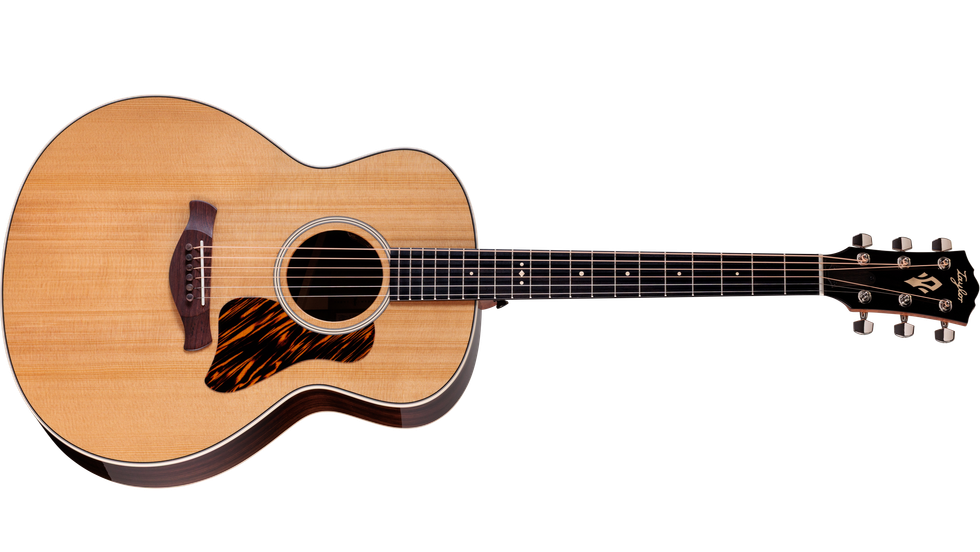
Indian rosewood and torrefied Sitka spruce showcase rosewood's characteristic deep lows, rich trebles and blooming overtones with impressive dynamic range. The model features understated appointments that channel the collection's workhorse spirit.
Gold Label 817e Grand Pacific
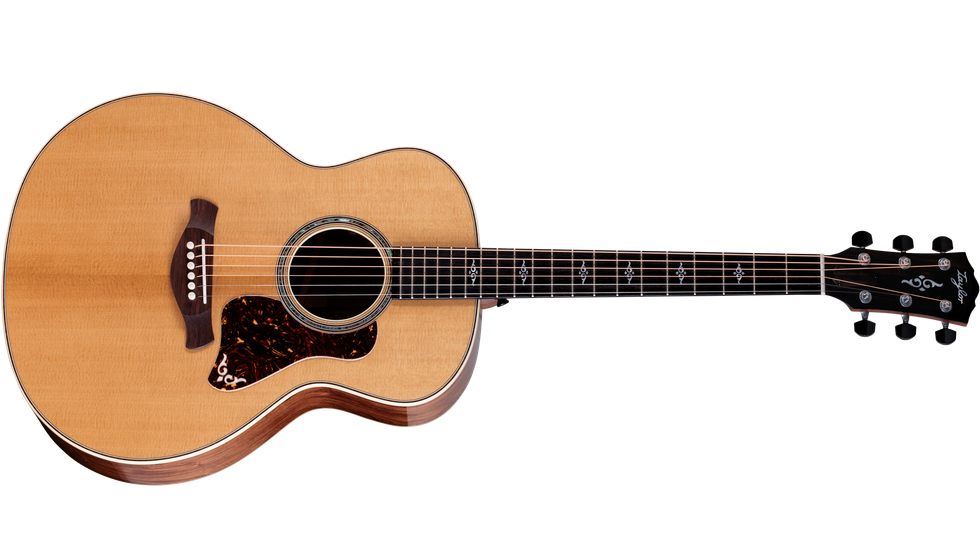
Honduran rosewood and torrefied Sitka spruce offer harmonically rich tone with inspiring old-school sonic character. The Grand Pacific body shape, with 3/8-inch of extra depth at the soundhole, provides greater volume, warmth and low-end expansiveness that are ideal for robust strumming and dynamic flatpicking.
Stage and Studio Acclaim
The Gold Label Collection has earned praise from both recording professionals and touring crews for its distinctive sound and innovative features. Producer/engineer Ben Moore, who has recorded guitar players for over 30 years, noted the collection's unique sonic character: "When a client opened the case and I saw a Taylor, I already had a sonic shape in mind before they strummed a single chord. The Gold Label guitars sound nothing like those guitars. The harmonic complexity
and midrange voice are nothing like any Taylor I have heard before. Microphones LOVE them.”
The Gold Label’s practical innovations have also won over touring professionals. "Having the 517e out on the road was such a treat,” said Matt Yankovich, Guitar Tech for Balance and Composure, and Mom Jeans. “The Action Control Neck is a touring guitar tech's dream come true — finally having the ability to quickly make action adjustments on the fly to keep things comfortable without needing to sand down saddles is an absolute game changer in the world of acoustic guitars."
The Gold Label 514e, 714e and 817e models are available now at authorized Taylor dealers worldwide starting at $2,599. All models include Taylor's Deluxe Hardshell Case and feature LR Baggs Element VTC electronics. For more information about the Gold Label Collection, visit TaylorGuitars.com.
EVH Launches 5150 Iconic Series 15W EL34 Head
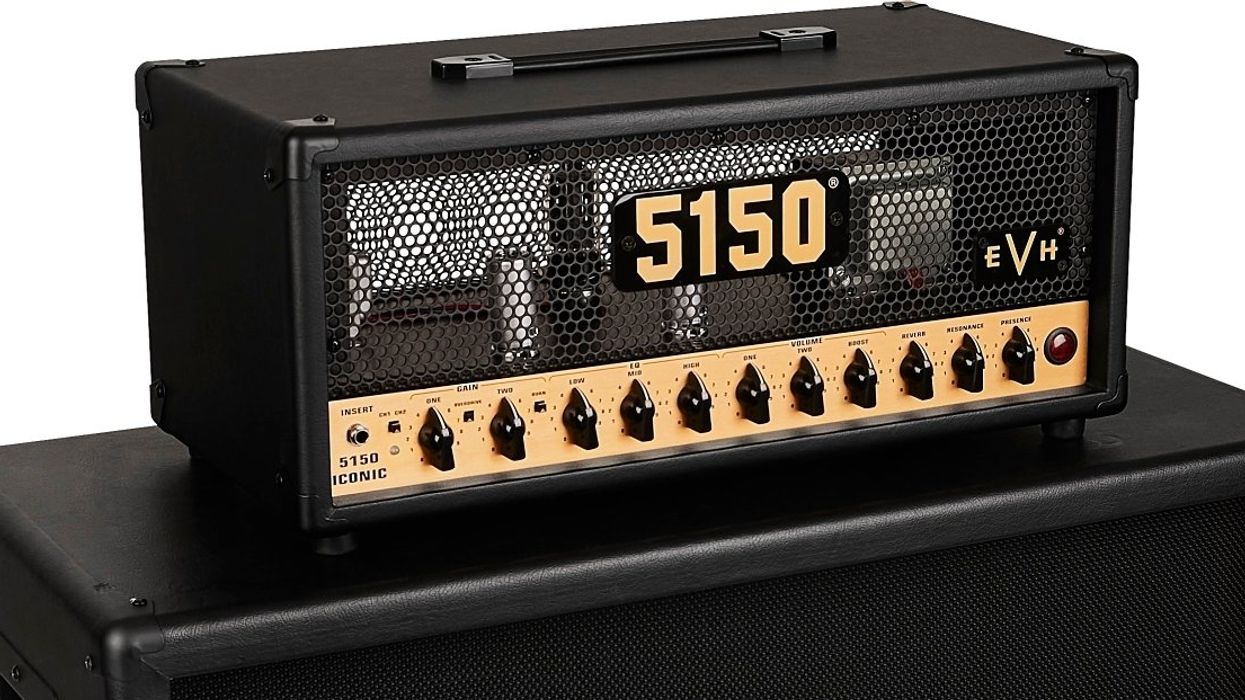
The EVH® 5150® Iconic® Series satisfies the needs of gigging and recording guitarists craving that powerful EVH tube tone, but at a more affordable price. Evolving from the revered EVH 5150III® amplifiers, the Iconic Series delivers the signature sound and growling gain that Eddie Van Halen made famous throughout his groundbreaking career.
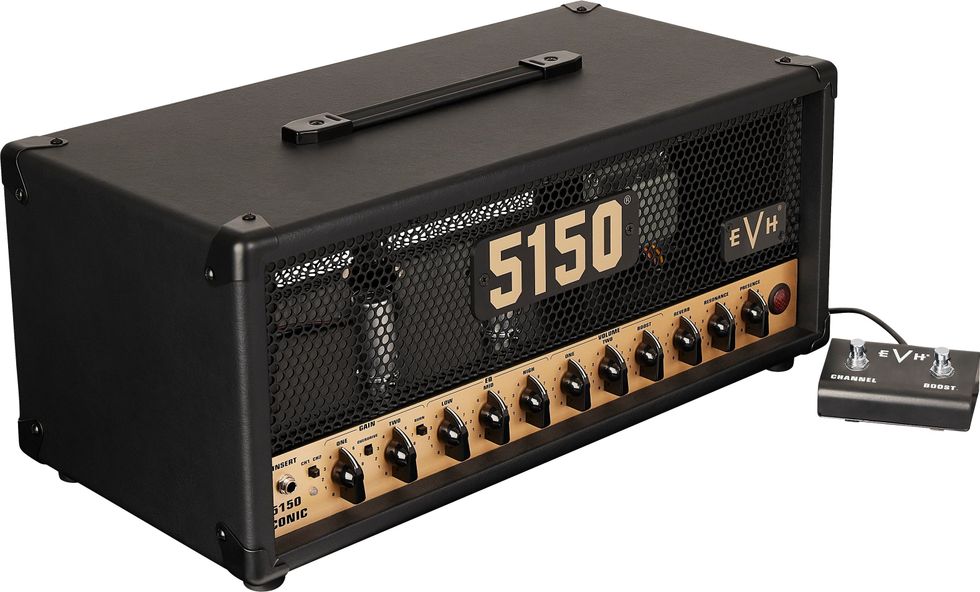
Designed by renowned amp engineer, James Brown, the 5150® Iconic® Series 15-watt Head is powered by one EL34 power tube and voiced by a complex, multi-stage hybrid preamp section anchored by a duet of ECC83 tubes providing all the fire power the modern guitarist needs.
Punching above its weight, this head features two channels with an extra voicing on each for even more versatility. The Green channel boasts an overdrive button to run from clean tones to increased gain, while the Red channel’s burn button adds fiery crunch that’s ideal for blistering leads. Each channel houses its own gain and volume controls, allowing for level-matching the volume when switching between the clean and high gain channels. The Boost control allows you to add another 10Db of foot-switchable volume to your tone - perfect for ensuring your solos cut through the mix.The control panel also includes shared EQ (Low, Mid and High), global resonance and presence knobs to adjust the low- and high-end aspects of your tone, and a global reverb to add the perfect amount of bounce and decay for any room.
Other features include a two-button footswitch, effects loop, dual parallel speaker output jacks, ¼ power switch to reduce wattage - allowing you to crank the amp and still preserve tone but without destroying your neighbor’s solitude, and a speaker-emulated DI XLR with power amp mute for accurate all-tube EVH tone for recording direct or using through any PA system. Sporting sophisticated and distinctive EVH style, the 5150 Iconic Series 15-watt Head is wrapped in Black textured vinyl with a brushed gold anodized aluminum front panel and black steel grille featuring gold and black 5150 and EVH logo badges. This This tube head is finished off with a brushed gold anodized aluminum control panel, vintage-style chicken-head knobs and molded black plastic top handle.
Learn more here.
D’Addario Introduces the Premium String Change Mat
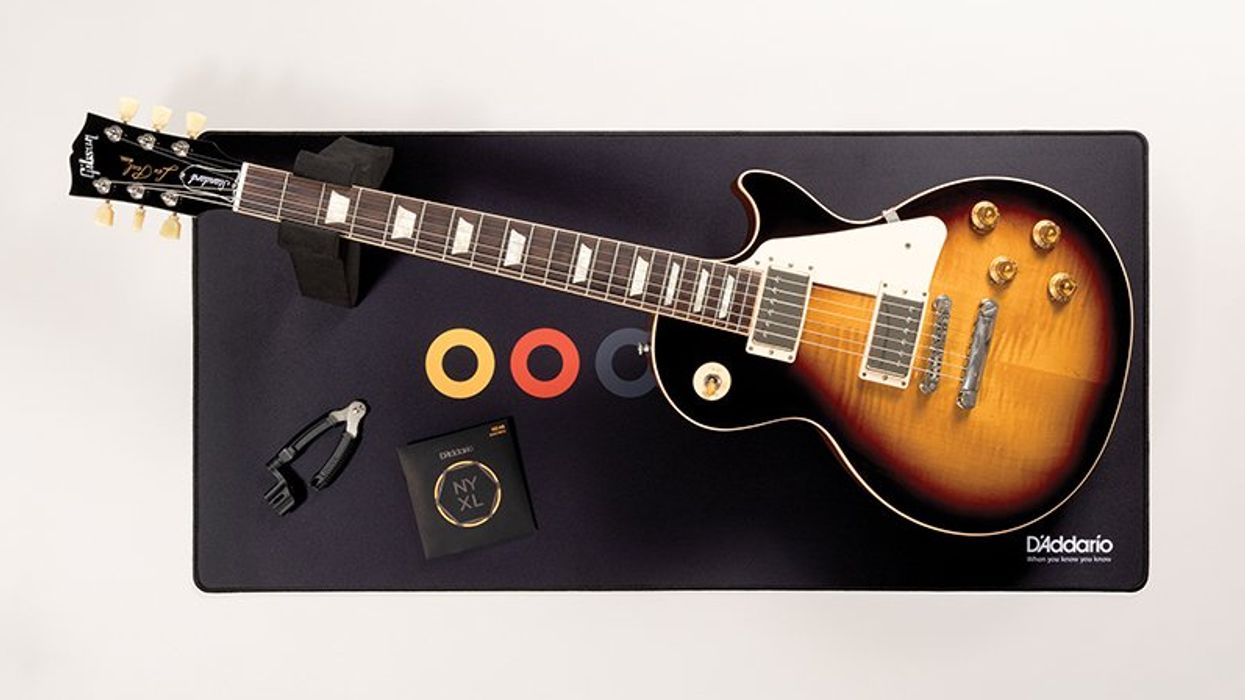
D’Addario announces the Premium String Change Mat, a must-have for luthiers, techs, and players who need reliable, finish-safe support during string changes and instrument maintenance.
Reliable Support for Every Restring & Repair
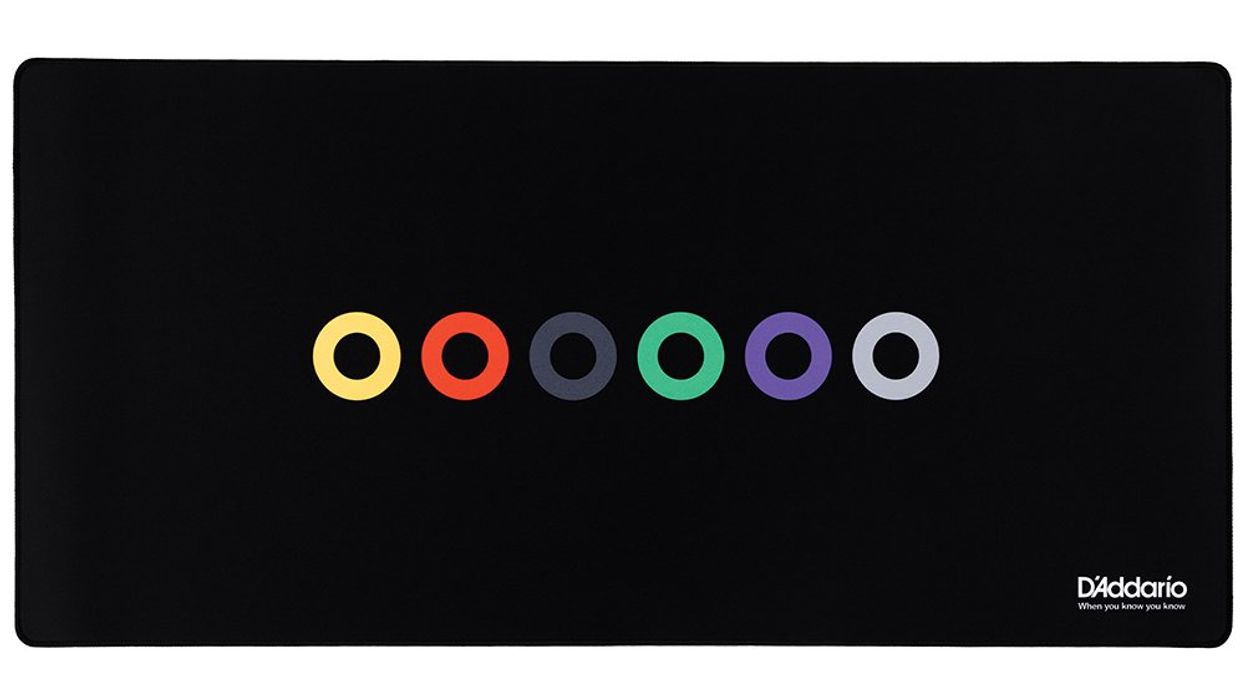
Designed with D’Addario’s iconic ball-end logo, the oversized mat measures 37.4” x 17.7”. On the surface is a soft, smooth fabric surface that’s safe for all finishes. Meanwhile, the underside is made of anti-slip rubber to ensure stability while you work, and the stitched edges improve long-term durability. Whether you’re performing an at-home tune up or prepping gear on the road, this mat keeps your instrument steady, protected, and scratch-free while you care for it.
A Must-Have Tool
"We want you to enjoy changing your strings. This mat was designed to be comfortable and functional, transforming your string change from a chore to a retreat," said D'Addario's Business Development Manager, Danny Mele.
Features:
- Soft, Smooth Fabric Surface
- Anti-Slip Rubber Underside
- Stitched Edge
- Ethically sourced and packaged with zero plastic
- D’Addario’s iconic ball-end logo
Product Info:
- Street Price: $29.99
- Available now at daddario.com and through participating retailers and distributors
- More Info: https://ddar.io/pscm-pr



